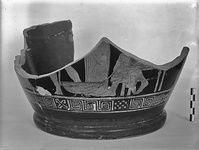Agora Object: Agora XXX, no. 1265 | Chronology: | | Ca. 430 B.C. | | Deposit: | | F 14:2 | | Published Number: | | AV 30.1265 | | References: | | Object: P 420
|
Lower part of wall and all of ring base. On underside of floor, three concentric circles with central dot. Most of the glazed fired red on the inside and on the outside below the figures. P.H. 0.15; diam. of base 0.15. L. Talcott, Hesperia 4, 1935, p. 479, fig. 3; Ginouvès, Balaneutikè , pl. 15:43; S. Pfisterer-Haas, Darstellungen alter Frauen in der griechischen Kunst, Frankfurt 1989, pp. 19--21.
A, uncertain subject. At the left, just next to the handle palmette, there is the base and start of the shaft of a column, then the lower drapery and feet of a woman standing to right. Next come the lower legs and feet of a frontal male with two spears or staffs. Next to him is a woman (draped legs, feet) to right and beside them on the ground, a basin. Last is a man (drapery, lower legs) seated to left on a stool, holding a staff or spear (part of shaft). B, lower drapery and feet of two women, the left one in a himation and a chiton standing frontally, the right one to left in a chiton. Below the figures, stopped-maeander pattern with saltire- and checkerboard-squares. Below each handle, encircled palmette configuration.
The object at the left behind the standing woman on Side A is more likely a column than a door post (pace Talcott, Hesperia 4, 1935, p. 478), for if it were the latter, one would expect to see part of the paneling to the left, and here there is only black glaze. Normally, the figure stands before the door post and does not overlap it. Cf. just a few examples that may stand for many: two by the Veii Painter: South Hadley, Mass., Mount Holyoke College, 1932 BS II.5 (ARV2 906, 109; Addenda 303) and Berlin 2261 (ARV2 906, 116; Addenda 303); Oxford 1961.468 by the Painter of Bologna 417 (ARV2 917, 202; Addenda 304); the namepiece of the Group of Athens 1591 (ARV2 955, 1; Addenda 307).
The subject on Side A is probably the return of Odysseus to Ithaca, specifically the moment before Eurykleia sees the identifying scar on his knee when she washes his feet (Odyssey 19.378--384). For the subject, see F. Brommer, Odysseus: Die Taten und Leiden der Helden in antiker Kunst und Literatur, Darmstadt 1983, pp. 100--102; also O. Touchefeu-Meynier, Thèmes odysséens dans l'arte antique, Paris 1968, pp. 248--256 with earlier bibliography and LIMC IV, 1988, pp. 101--102, s.v. Eurykleia (O. Touchefeu). The subject is not a very frequent one, and usually Eurykleia is already kneeling on the ground as she is on Rhodes 14174, an unattributed 4th-century pelike (Clara Rhodos 6--7, 1932--1933, pp. 458--459, figs. 13, 14) and the compositions as well as the participants vary considerably, suggesting that there is no one prototype. But in at least one example Eurykleia stands, in this case immediately after the recognition: Athens, N.M. 1914, a 4th-century Thessalian relief (see S. Karouzou, National Museum: Catalogue of Sculpture, Athens 1968, p. 155, pl. 46; C. Robert, AthMitt 25, 1900, pl. 14). If the identification of the subject on 1265 is correct, the figures, reading from left to right, might be Penelope, Eumaios or Telemachos, Eurykleia, Odysseus. Since the figure I propose to call Eurykleia stands quietly and is not alarmed, she probably has not yet washed Odysseus' feet. The exceptional quality of the foot bath (Ginouvès, Balaneutikè , p. 64) may also favor this interpretation.
The drapery of the figures identified as Eurykleia and Odysseus bears some similarity to that on Boston, M.F.A. 95.25 in the manner of the Kleophon Painter (ARV2 1149, 9; Paralip. 457, 9; Addenda 335; Matheson, Polygnotos, p. 412, cat. no. KL 30, pl. 131: the painter himself).
|
